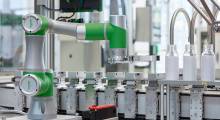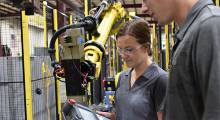The manufacturing sector is undergoing dramatic transformation amid several challenges, such as residual effects of the pandemic, rising fuel prices, and armed conflict in Europe, which continue to disrupt global economies.
For several years, researchers and stakeholders in the manufacturing sector have been proposing numerous ideologies and solutions to perennial manufacturing problems. 2022 is the ideal year for manufacturers to implement these ideas to improve efficiency and remain competitive globally.
Although we have seen increased automation on the factory floor for decades, 2022 is the year to accelerate your adoption. The advent of the Internet of Things (IoT), cloud computing, 4G and 5G networks, artificial intelligence and robotics all help companies to achieve better productivity, counter skilled labor shortages, and autonomously adjust operations to match the fluctuating consumer demands at a fraction of the cost of traditional approaches.
Most digital manufacturing concepts have undergone sufficient industrial tests and are now mature enough for implementation in different facilities. Implementing robotics on the factory floor is becoming inevitable due to its versatility and compatibility with emerging technological trends. Such progress aligns with most manufacturers’ goals.
So what’s so special about 2022? Why should manufacturers accept technological changes and transformative ideas now?
Increased global competition
Manufacturers are experiencing stiff competition from their global peers. Every company is exploring ways to reduce production costs while maintaining product quality. The modern consumer is savvy and is always on the lookout for affordable, high-quality products. Companies try to beat the competition in several ways, including:
- Shifting operations to regions/countries with low labor costs
- Digitizing operations
- Optimizing supply chains
The competition extends to scarce raw materials. Manufacturers are increasingly investing in research and development to gain insights into consumer behaviors, quality improvements, alternative manufacturing materials and processes, sustainable manufacturing infrastructure, and in-house employee training needs.
As Industry 4.0 takes over the manufacturing space, companies must implement solutions that promise to increase the competitiveness of the brands on a global scale. These companies should adopt customer-centric solutions that lower production costs. That way, they can grow their customer bases, venture into new products, and enhance product quality.
Shortage of skilled labor
The manufacturing business is labor-intensive and targets highly-skilled individuals. Everything from production to operations and maintenance demands the highest levels of precision. Unfortunately, the manufacturing sector is experiencing a shortage of skilled labor.
There is an increasing demand for workers with multiple skill sets to operate advanced production systems. This trend is evident across the world and has pushed labor costs to a record high – including in countries usually considered low-cost labor markets.
One way to counteract the labor shortage in manufacturing is the increased adoption of robotics, including autonomous mobile robots (AMRs), automated guided vehicles (AGVs), and related technologies. The technologies are vital because they can:
- Reduce labor costs.
- Reduce reliance on human labor, enabling companies to phase out an aging workforce without interrupting production processes.
- Promote continuous improvement standards
In addition, companies must establish measures for continuously upskilling their workforce. Manufacturing floor employees should understand how emerging digital technologies enhance manufacturing efficiency. This facilitates the seamless integration of automated systems into established practices.
Increased demand for sustainable operations
The manufacturing sector has received a lot of backlash from environmental conservationists due to the high levels of greenhouse gas emissions, environmental degradation, noise pollution, and emission of toxic waste. Some of the effects of old manufacturing practices will take years to reverse.
As the world enters a new age of manufacturing, there is an increased demand for stakeholders to implement sustainable practices. It involves using renewable energy resources, limiting greenhouse gas emissions, reducing reliance on scarce natural resources, proper effluent treatment, recycling waste, and increasing process reliability to minimize manufacturing waste.
Manufacturers worldwide are racing against time to establish effective carbon management measures. There is heavy investment in research of alternative manufacturing materials and reduced reliance on fossil fuels to power manufacturing facilities.
Manufacturers require the goodwill to undertake operational reforms and invest in relevant technologies to monitor pollution and measure progress. Companies that fail to undertake these precautions in time will likely lose their competitive advantage and struggle to achieve production targets.
Post-pandemic supply chain stabilization
The COVID-19 pandemic challenged supply chain regimes across the world. The temporary closure of ports of entry deprived manufacturers of critical supplies, which in turn caused a slowdown in manufacturing activities. In 2022, most sectors of the economy are rebounding. Governments are slowly easing pandemic control measures, and international borders are opening up.
Manufacturers learned several lessons from the pandemic period. The financial losses, which ran to billions of dollars, were a wake-up call for manufacturers to explore innovative methods to increase supply chain resilience.
Manufacturers are struggling to replace all jobs lost during the pandemic. Some companies are reshoring manufacturing activities, reducing reliance on overseas partnerships.
Manufacturers should also accept new ideas for securing and strengthening supply chains to avoid future challenges, should a similar pandemic or political tension occur.
Enhanced factory digitization
Digitization increases autonomy and efficiency on the factory floor. Industry 4.0 is all about the smart factory. Companies are focusing on on enhancing equipment connectivity through IoT sensors, customizing production and predicting market trends in advance.
The use of robots for diverse production activities enhances modular production, warehouse management, quality inspection, and prototyping initiatives. The digital age extends to advanced design software, which improves the product development process. Companies can create digital twins to iterate complex part designs.
Companies should adopt IoT sensors to monitor the real-time performance of different production assets and collect sufficient analytical data to predict defects and rectify them before failing.
Collaborative robots can perform diverse tasks, enabling quicker turnaround time and completion of complex or high-risk activities. Condition-monitoring sensors and remote monitoring systems collaborate with advanced wireless technologies and cloud systems for ultimate data management.
Adopting digitization in 2022 will enable manufacturers to improve data collection and analysis, as well as optimization initiatives. It will also increase productivity and reduce unplanned downtime and undesirable manufacturing losses.
Manufacturing reaches a turning point
Manufacturers have consistently overcome severe challenges over the years. The pandemic has been a turning point in the recent history of manufacturing. At the same time, political tensions are increasingly piling pressure on already strained supply chain systems.
Luckily, manufacturers have access to transformational ideas and viable systems that can ease emerging operational challenges. Integration of digital technologies promises to transform the manufacturing sector as the world gears towards Industry 4.0.

About the author
For over 30 years, Eric Whitley has been a leader in the manufacturing space. After an extensive career as a reliability and business improvement consultant, Whitley joined L2L, where he currently serves as the director of smart manufacturing. In addition to contributing articles to many publications, Whitley's role in this position is to help clients learn and implement L2L’s approach to corporate digital transformation.
Article topics
Email Sign Up
















